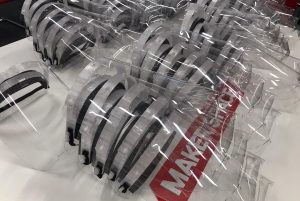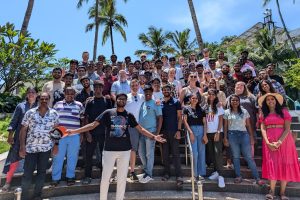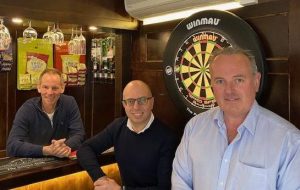Experts rally to help protect frontline NHS staff

Academia and the commercial sector are joining forces to support the NHS in its battle against the coronavirus.
Resources are being diverted to ramp up 3D-printing efforts to provide adequate supplies of personal protective equipment (PPE) for those on the front line of health care.
Engineers at the University of Liverpool are using their expertise in 3D-printing and laser cutting technologies to produce protective visors for use by local hospitals.
The protective visors, developed in conjunction with NHS staff at local hospitals – including the Royal Liverpool University Hospital, Broadgreen Hospital, Aintree University Hospital and Southport & Orrmskirk Hospital Trust – use a hybrid design approach with a laser-cut top section and a 3-D printed bottom section.
Laser cutting technology reduces the production process significantly from six hours to half-an-hour and local industry is helping to scale up production further.
Staff and PhD students, based in the university’s Active Learning Laboratory, are using their technical facilities and expertise to produce an initial batch of 50 to 100 protective visors per day, with the intention of increasing this to 300 per day over the coming weeks.
The protective visors will be delivered to three hospitals in the local region in the next few days, with other local hospitals soon to follow suit.
Dr Kate Black, an expert in additive manufacturing at the University of Liverpool, said: “Thanks to 3D-printing and laser cutting technology, our team of engineers have been able to design a protective visor that can be produced in about half-an-hour.
“We have worked closely with our local NHS hospitals on the design and now that they are happy with it our dedicated team of staff and PhD students from the university are ready to start production so that we can help protect our health services staff at this time of extraordinary need.”
Dr Paul Fitzsimmons, deputy medical director at Liverpool University Hospitals NHS Foundation Trust, said: “I’d like to thank Dr Black and her team for all their amazing work in designing and producing these visors and not only getting them to our hospitals so quickly, but for sharing the information required to make them with colleagues across the UK and help hospitals access more of the equipment they need in the fight against coronavirus.”
Prof Louise Kenny, executive pro vice chancellor of the University of Liverpool’s Faculty of Health and Life Sciences, said: “The COVID-19 pandemic presents an unprecedented global challenge, and staff and students across our faculties and departments here at the University of Liverpool are coming together in all sorts of ways to provide their expertise, facilities and innovation to manage, mitigate, and eventually stop this virus.”
The team is working to capacity to deliver the current order for local NHS partners and, unfortunately, is unable to consider any additional requests for protective visors.
Meanwhile, a specialist manufacturing facility in Salford is using its 3D-printing capabilities to produce medical visors for NHS staff.
Teams at the Morson Engine Room and Maker Space – a state-of-the art engineering and digital fabrication facility based at The University of Salford and funded by Salford-based global recruitment specialist, the Morson Group – recently developed a prototype medical visor using 3D-printing in direct response to the needs of hospital staff fighting coronavirus.
Following initial testing, it has now been tasked with producing 75 visors a day, donating the products to Salford Royal Foundation Trust.
Developed using the open-source Prusa design in partnership with Salford Royal Hospital, the visor aims to be 90% sterilisable.
Following approval, the design will now be sent out to commercial fabricators and other university technical departments in the North West to scale production and meet the numbers needed for NHS frontline staff across the UK.
The Morson Engine Room and Maker Space was established in 2019, with the ambition of collaboration between the University of Salford and local businesses to innovate and test ideas, with an opportunity to meet and work on real industry briefs.
Featuring a ‘Print Hive’, the facility is kitted out with dedicated 3D-printing machines comprising a range of Ultimate S5, 3 and 2+ machines, a Markforged composite printer, Markforged Metal X, and a high-resolution SLA resin Formlabs printer.

Morson Engine Room and Maker Space visors
Other equipment includes laser and vinyl cutters and space for assembling electronics, with a dedicated CAD Studio for 3D design classes.
Dr Maria Stukoff, director of the Maker Space, said: “I can’t emphasis enough how proud I am of the team at our facility who re-opened our Print Hive to 3D make PPE visors and now form part of the efforts around the country to support front line workers in the NHS.
“I commend their drive and goodwill in this current health crisis, and it is a testament to their maker commitment to support the community and local partners when it counts most.
“We are glad to be able to play a role in the global fight against this pandemic and are grateful of the equipment and facilities within our space that have enabled our team to achieve this.”
Ged Mason, chief executive of the Morson Group, said: “There is a nationwide, collective response to do what we can to fight this pandemic.
“When we launched the Morson Engine Room and Maker Space it was with this exact aim in mind – to provide the equipment required to enable students to respond and react to real life challenges which can be overcome using technology.
“The way the technical team at the facility has gone above and beyond to create these innovative visors is astounding. Even when met with a global crisis, they have put other people first and used their shared talent to make a difference.
“If we can take one thing from the COVID-19 outbreak, it is that it is revealing humbling things about people we know and work with.”








